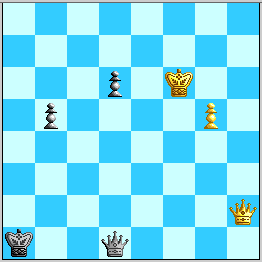
Diagram 1: White to move and win.

Diagram 1: White to move and win.
Here 54. g6? allows 54...Qd4+! 55. Kf7 (other moves allow 55...b4=) Qc4+! 56. Kf8 Qc8+ 57. Ke7 (57. Kg7 b4! 58. Qg1+ Ka2 59. Qf2+ Ka3! appears to draw with little trouble for Black) Qc7+ 58. Kf6 Qc3+! (58...Qd8+?! 59. Kg7! may lose) 59. Kf5 (59. Kg5 allows 59...b4=) Qc5+! 60. Kg4 (what else?) b4! 61. Qh1+ (61. g7? Qd4+; 61. Qh8+ Kb1 62. g7 Qc4+ is a perpetual) Ka2 62. Qg2+ Ka3! 63. g7 Qc4+
Hence White muse choose a non-checking Queen move, and only two candidates really present themselves, 54. Qf4 and 54. Qf2. After both moves Black's plausible responses are the same: 54...b4, 54...Qd3, or 54...Qd5. One White move better centralizes the Queen, covers b4, and more closely assists White's pawn. The other move is the one that wins.
Many World Team analysts feared 54. Qf2 most during the game because it was discovered that three of Black's four plausible responses lose quickly:
A) 55...Qd5 56.g7 Qe5+ 57.Kf7 Qd5+ (57...Qh5+ loses to 58.Kf8 Qh6 59.Qf5! b3 60.Kf7 b2 61.g8=Q b1=Q 62.Qa8+) 58.Ke7 Qe4+ (58...Qb7+ 59.Kf6, and White wins, or 58...Qg8 59. Qf8 +/-) 59. Kd8 Qa8+ (59...Qg6 60. Qd4+ +/-) 60. Kc7 Qg8 (60...Qa5+ 61. Qb6 Qg5 62. Qd4+ +/- or 61...Qd5 62. Qg1+ +/-) 61. Qf8 Qc4+ 62. Kd8 Qh4+ 63. Qe7 Qg3/g4 64. Qf7! Qg5+ (64...Qh4+ 65. Kc8! Qg4/h3+ 66. Kb8 +/-) 65. Ke8 Qb5+ 66. Kf8 Qb8+ 67. Qe8 +/-, or 65...Qe5/e3+ 66. Kf8 Qh6 67. Qf5! +/- as before.
B) 55...b3 56.g7 Qg4 57.Qe1+ Ka2 (57...Kb2 58.Qd2+ Ka3 59.Qa5+ Kb2 60.Qd5 transposes) 58.Qa5+! Kb2 (58...Kb1 59.Qf5+, and White wins) 59.Qd5 Qf4+ 60.Ke7 Qe3+ (60...Qh4+ 61.Ke8 Qa4+ 62.Kf8 Qf4+ 63.Qf7 Qh6 64.Qf5 Ka1 65.Kf7 b2 66.Qa5+ Kb1 67.g8=Q, and White wins) 61.Kf8 Qh6 62.Qf5 Ka1 63.Kf7 b2 64.Qa5+ Kb1 65.g8=Q, and White wins.
II. 54. Qf2 Qg4 55. g6 leaves Black without checks and with no better option than transposing to I.B) with 55...b4 56. g7 b3.
III. Defending with 54…Qd5 is also fruitless. White continues 55.g6! Qe5+ (for 55...b4 see 54...b4 55.g6 Qd5) 56.Kf7 Qd5+ (for 56...b4 57.g7 see 54...b4 55.g6 Qd5 56.g7 Qe5+ 57.Kf7) 57.Kf8 Qa8+ 58.Kg7! (not 58.Ke7 Qe4+, and Black is OK), and now:
A) 58...Qb7+ 59. Qf7! Qe4 60. Qf1+ Ka2 61. Qxb5 is EGTB mate in 50, which is relatively quick as these things go. Nor does 59...Qg2 60. Qa7+ Kb1 61. Qd4! look like much hope for Black.
B) 58...Qe4 59.Qf1+ Ka2 (59...Kb2 60.Qxb5+, wins for White) 60.Qxb5, and White wins.
C) 58...b4 59.Qe1+ Ka2 60.Qxb4 does not require a tablebase to assess as +/-.
With such quick bang-bang wins, we knew Black was down to the one
defense 54. Qf2 Qd3. However, at game time we felt this defense was
promising, because after the natural 55. g6, Black has 55...Qc3+ 56.
Kf7 Qc7/c4+ 57. Kf8 Qc8+ 58. Kg7 d5!
(Note: Fritz worked out that 58...Qc3+ 59. Kh6 is strong for White, and 58...b4? 59. Qe1+ Ka2 60. Qxb4 is indeed a tablebase loss. 56. Kg5 b4! 57. Qa7+ Kb1 58. g7 Qe5+ is an instance of an "e-file block": 59. Kg6/h6 Qe6+ 60. Kh7 Qh3+ 61. Kg8 b3 is a draw.)
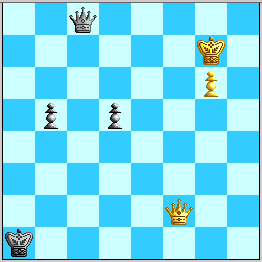
Diagram 2, after 58...d5---the "Solnushka defense" to 54. Qf2 Qd3 55. g6.
The worth of this defense was demonstrated in posts by "Solnushka", and seems to withstand scrutiny-chez-EGTBs now. White's basic tries are:
(a) 59. Qe1+ Kb2! (59...Ka2 allowing White to pick up the b-pawn with check loses) 60. Kf6 (see next lines for 60. Qb4+ and 60. Qe2+) Qf8+ 61. Kg5 Qd8+!, and now 62. Kg4 Qf6! (62. Kf5 Qf8+ 63. Kg4?! Qf6! is the same) looks like a cold draw, e.g. after 63. Qb4+ Ka2/c2 64. Qa5/c5+ Kb2! 65. Qxb5+, all six King flights draw! But also 62. Kh5 Qh8+ 63. Kg4 d4 equalizes, so White has nothing.
(b) 59. Qd4+ Kb1 (maybe better 59...Ka2 here, as 60. Qxd5+ is EGTB=) 60. Kh6 Qe6 (...Qh3+ might not lose here...?) 61. Qb4+ Kc2 62. Qc5+ Kd1/d2 and White gets no further. And if White tries to re-"Zug" by 61. Qg1+ Kb2 62. Qf2+ Kb1 63. Qd4, Black can safely play 63...Ka2 64. Kg5 Qe7+ (note: 64...b4 65. g7 b3 66. Qa4+ Kb2 67. Qg4! wins for White, I believe) 65. Qf6 Qe3+ 66. Qf4 Qe7+ 67. Kh6 Qe6, as 68. Qf3 is now met simply by 68...b4 and 69. Kh7 is not in time. And after 68. Qf7(!), the extra b-pawn makes this more dangerous for Black, but 68...Qe3+! 69. Kh5 Qe5+! or 69. Kg7 b4! (not ...Qe5+) leads to lines from 51...Ka1 that are OK for Black.
(c) 59. Qf1+ Ka2 (59...Kb2? 60. Qxb5+ is EGTB+/- #80) 60. Qe2+ (60. Qxb5 EGTB=), and now Black has a difficult choice:
c1) 60...Ka1!? and now:
c11) 61. Qe5+ d4! and Black seems OK as 62. Qxd4+ is EGTB= and King moves go nowhere as Black has enough checks and White cannot offer a trade of Queens. But we might have been very nervous about this self-pin and losing a pawn on d4 with check...
c12) 61. Kf6 Qf8+ 62. Kg5 Qd8+ (62...b4? 63. Qe5+! and 62...d4?! 63. Qe5! both look winning for White) 63. Kf5 Qf8+ 64. Kg4 Qf6! and Black is fine.
c2) 60...Ka3!? Now 61. Kf6 is still fruitless as in (a), and 61. Qxb5 is still EGTB=. But White has:
c21) 61. Qd3+ Ka2!? (61...Ka4 should also be AOK, e.g. 62. Qxd5 is a draw even with White to move) 62. Kf7 (62. Qxd5+ is EGTB=, all King flights draw; 62. Kf6 allows 62...b4!? 63. g7 b3 64. Qxd5 Qc3+! EGTB=, though Black could also continue as in this main line) Qd7+ 63. Kf6 Qd8+ 64. Kf5 Qf8+ 65. Kg5 Qe7+!? 66. Kg4 b4! This was also possible a move ago, and in either case, it seems to be a clean draw. [Black avoided 66...Qf6?! here because of 67. Qf5!, the point of White's play, e.g. 67...Qd4+ 68. Qf4 Qg7?! 69. Qf7! Qd4+ 70. Kf5! and this looks like a winning case of the Pin Battery for White. Also, 66...Qg7!? (and idea due to Khalifman that is generally supported by Karrer's EGTBs in analogous lines without Black's b-pawn) may be good enough: 67. Qxd5+ Ka3! EGTB= (but here other King flights lose!) or 67. Qf5 b4!]
c22) 61. Qe3+ Ka2 (again, 61...Ka4 is probably fine too, as 62. Qa7+ Kb3 63. Qf7 b4! de-fangs the Pin Battery) 62. Kf6 (62. Kf7 Qf5+) Qf8+ (62...b4!?) 63. Kg5 d4! Now 64. Qxd4 b4/Qe7+ is EGTB=, as is 64. Qd2+ Kb1 65. Qxd4 Qe7+! EGTB=, and here 65. Qd3+ Ka2! (65...Kc1? 66. Qxd4 is EGTB+/- #38 basically owing to the cross-check at f4) 66. Qf5 Qd8+ 67. Qf6 Qd5+ equalizes as Black will play ...d3! as soon as White's King moves. White's other try is 64. Qe6+, when 64...Ka1/b2? 65. Qe5! is probably winning for White, and 64...Kb1 is nervous but seems OK after 65. Qe4+ Ka2 (65...d3? 66. Qxd3+ EGTB+/- #42) 66. Qd5+ Ka3! as 67. Qxd4 b4/Qe7+ is EGTB= and 67. Qxb5 is likewise). But 64...Ka3!? 65. Qa6+ Kb4! (65...Kb2? 66. Qxb5+ EGTB+/- #37) seems most comfortable of all, or 65. Qe5 Qd8+ 66. Kh5 d3=.
[Footnote: If Black inserts 63...Qd8+?! 64. Kf5! Qf8+ 65. Kg4! then 65...d4? 66. Qxd4 is suddenly EGTB+/- #62, and I believe Black is in trouble---this is similar to "Line B" in my post on 51...Qf3.]
c23) 61. Qf3+ Ka2!? (here 61...Ka4 really does look more prudent) and now:
c23a) 62. Kh6 Qh8+! (62...Qe6? 63. Kh7+/-, but note that 62. Kh7 was met by 62...Qc2, when 63. Qxd5+ is drawn and 63. Kh6 Qh2+ looks like transposing after 64. Kg5 Qe5+) 63. Kg5 Qe5+ 64. Qf5, and we have transposed to a note of the 51...Ka1 analysis, reached by 51. Qh7 Ka1 52. Qg7+ Ka2 53. Qf7+ d5 54. Kh7 Qc2+!? 55. g6 b5 56. Kh6 Qh2+ 57. Kg5 Qe5+ 58. Qf5, where Black is holding.
c23b) 62. Kf7 Qd7+ 63. Kf6 Qd8+ 64. Kf5 Qd7+ 65. Kg5 (65. Kf4 Qd6+ 66. Kg5 Qe5+ transposes to b23a) b4! 66. Qf2+ Ka3 67. Qf7 Qd8+, and even though White's forcing Black's King to a3 makes a check on f8 deadly after both pawns advance, Black survives because White can't quite evade the checks: 68. Kf4 Qh4+, or 68. Kh5 Qh8+, or 68. Kg4 Qc8+ 69. Kh4 Qc4+ =.
Looking White's Kf6 attempts in these (c) lines may give a clue as to why Kasparov played 54. Qf4 in the game. That White would win by 59. Kf6! after the analogous "Solnushka" line 54. Qf4 Qd3 55. g6 Qc3+ 56. Kf7 Qc7+ 57. Kf8 Qc8+ 58. Kg7 d5 is demponstrated here. White's Queen on f4 provides crucial needed support for this "King dance" back to g5 and g4.
However,
if these defenses weren't
nerve-wracking enough, Regan posted some worry about 54. Qf2 Qd3 55.
Qe1+, noting the lines 55...Ka2 56. Qe6+ with a centralizing check,
and 55...Kb2 56. g6 Qd4+ 57. Kf7 Qf4+ leading to trouble after 58.
Ke8! Here White's command of the central e-file and the configuration
of Black's pawns conspire to deny Black any further checks, and
White's win thereupon resembles the end of Kasparov
and Alterman's professed win against
58...Qf5. Analysis conducted in December
indicates that this worry was well-founded, as even Black's strongest
defense 55...Kb2 56. g6 Qf3+ 57. Kg5 Qg2+ 58. Kh6 Qh3+ 59. Kg7 Qf5!
goes down after 60. Qe7!, exposing defects of Black's King being on
b2. Hence 54. Qf2! is a winning move for White, and the demonstration
is completed here.
Hence 54. Qf2! is a winning move for White.
In any event, this explains the considerable relief of us and some other World Team members when Kasparov actually played
54. Qf4?
Suddenly all three of Black's main defensive moves were on again! The explanation for the losing reply
54. ... b4?
parallels what Nikolaus Krogius called the "Retained Image" in his book on the psychology of over-the-board chess blunders. We knew 54. Qf2 Qd5 was a quick loss, and were nervous about 54. Qf2 Qd3, and then saw the extra effectiveness of White's Queen on f4 compared to the main 54. Qf2 Qd3 lines. Hence Irina in particular expressed a gut feeling that both 54...Qd3 and 54...Qd5 were "no better than a 30% chance for Black". By contrast, the World Team quickly verified that the quick winning line against 54. Qf2 b4 did not apply to 54. Qf4 b4---and experience with the 51...Ka1 analysis taught that Black was losing the "Qf7 Pin Battery" lines because of the b-pawn. What we didn't do was check in depth whether 54. Qf4 Qd5 was safe---although we did note the line 55. g6 b4! 56. g7 b3 57. Qa4+ Kb2 58. Qg4 as only drawing for White. We may have figured that instead 55. Qf1+ Ka2/b2 56. Qf2+ would transpose into the quick-loss lines (whose image we had retained)...but we shall now demonstrate that 56...Ka3! holds for Black. The strength of the "Retained Image" was such that even while compiling this analysis in December, we thought that posts by "Spy49" titled "Another Qd5 loss" and the like had been on 54. Qf4 Qd5, whereas they had been on 54. Qf2 Qd5 and already incorporated into our "Line III" analysis above in this file.
What we supposed was that both White Queen moves had a loophole, 54. Qf2 Qd3! being one and 54. Qf4 b4 being the other---and we figured Kasparov made his choice to challenge the psychology of whether the World would part with a pawn. Ironically, if we had rejected 54...b4, we might well have gone with 54...Qd3, because IM2429 found what looked like possibly a second loophole: 54. Qf4 Qd3 55. g6 Qc3+ 56. Kf7 Qc7+ 57. Kf8 Qb8+! 58. Kg7 b4!, and now 59. Kh7 Qa7+! 60. g7 b3 61. Qf6+ b2 62. Kh8 is not "1-0" but 62...d5!! 63. g8=Q d4, draw! Regan fell into this trap in a post; could Kasparov have? Most World Team members (and most e-mailers to SCO criticizing 54...b4 at the time) favored 54...Qd3; Bacrot recommended 54...Qd5 but with no supporting analysis. However, 54...Qd3 now appears to be also a losing move, because White has a psychedelic win in this line!
Current analysis indicates that the centralizing 54…Qd5! holds the position for Black.

Diagram 3. Does Black really find salvation on the back row?
This move looks uncomfortable as Black has no checks at all, but the Queen usefully covers g8 and releases Black's b-pawn for action. There seem to be two main branches for White:
A. 55.g6 b4! and now:
A1) 56.Qxb4 Qe5+ 57.Kf7 Qf5+ 58.Kg7 Qe5+ 59.Kh7 Qh5+ 60.Kg7 Qe5+ 61.Kh6 Qh8+ 62.Kg5 Qe5+, with a draw.
A2) 56.Qf1+ Ka2, and now:
A2a) 57.Qe2+ Ka3 58.g7 Qd4+ will hold, e.g. 59.Kg6 Qg1+ 60.Kf7 Qa7+ 61.Qe7 Qf2+ 62.Ke8 Qg2 63.Qf8 Qc6+ 64.Kd8 Qa8+ 65.Kc7 Qa7+ 66.Kxd6 Qd4+ 67.Kc6 Qc4+ 68.Qc5 Qe4+ 69.Kc7 Qf4+ 70.Kd8 Qf6+ 71.Qe7 Qb6+ 72.Ke8 Qb8+ 73.Kf7 Qf4+ 74.Qf6 Qc7+ 75.Ke6 Qc6+ 76.Ke5 Qc3+ 77.Kf5 Qf3+ 78.Kg6 Qg4+ 79.Kh6 Qh3+ 80.Kg5 Qg3+
A2b) 57. Qf2+ Ka3 58.Qg3+ b3 59.g7 Qd4+, with equal chances.
A3) 56.g7 b3 (but not 56...Qg8? 57.Qf1+ Kb2 58.Qe2+ Ka1 59.Qe6, and White wins), and now:
A31) 57.Qf1+ Ka2 58.Qg1 (58.Qa6+ Kb1, equal) 58...Qe5+, equal.
A32) 57.Qa4+, and now not:
A321) 57...Kb1? 58.Qg4 Qe5+ 59.Kf7 Qd5+ 60.Qe6 Qb7+ (60...Qf3+ 61.Ke7 Qb7+ 62.Kf6 Qf3+ 63.Qf5+, or 60...Qh5+ 61.Qg6+, win for White) 61.Kf6 Qf3+ 62.Qf5+, and White wins, but instead:
A322) 57...Kb2, and Black is OK, for example:
A3221) 58.Qe8 Qd4+, equal.
A3222) 58.Qf4 Ka1 59.Qc1+ Ka2 60.Qg5 Qg8 61.Qa5+ Kb2 (61...Kb1 62.Qe1+ Kc2 63.Qe2+ transposes) 62.Qd2+ Kb1 63.Qe1+ Kc2 64.Qe2+ Kc1, equal.
A3223) 58.Qg4. This appears to be White's intent, but after 58...Qe5+, both directions for White's King come up short:
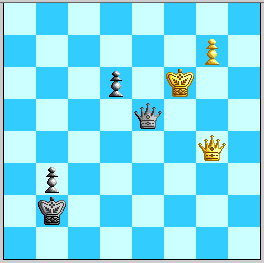
Diagram 4. Would Kf7 win if Black's d-pawn were on d5---?
A32231) 59.Kf7 Qd5+, and now:
(a) 60. Kf8 Qa8+ 61. Ke7 Qg8!
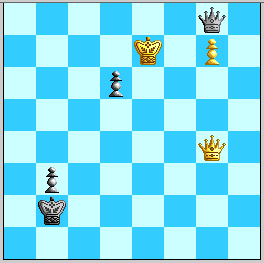
Diagram 5. The back-row defense. White would need the Knight-hop Qg4-f2+ to win.
Now 62. Qd4+ Ka2! 63. Qa7+ Kb1! 64. Qg1+ Ka2! keeps White at bay, as do 62. Qe2+ Ka3! and 62. Qg6/g3 Ka2! and 62. Kf6 Ka3.
(Another way to reach a saving back-row defense is to play 61...Qa7+ 62. Kf6 Qf2+ 63. Kg5 Qf7! 64. Kh4 Qg8!, while 63. Kg6 Qc2+ 64. Qf5 Qc4 transposes into the next line, and Black could play ...Qd2+ in response to Kg5 as well.)
(b) 60.Qe6 Qb7+ 61.Kf6 (61.Kf8 Qf3+ 62.Qf7 Qa8+ 63.Ke7 Qb7+ 64.Kf6 Qf3+ 65.Ke6 Qe3+ 66.Kxd6 Qd4+, is equal. Also a draw is 61.Kg6 Qg2+ 62.Kh7 Qh2+ 63.Qh6 Qc2+ 64.Kh8 Qc3 65.Qxd6 Qh3+ 66.Kg8 Qf5 67.Qf8 Qd5+ 68.Qf7 Qa8+ 69.Kh7 Qh1+ 70.Kg6 Qg2+ 71.Kf6 Qf3+ 72.Ke7 Qb7+ 73.Kf8 Qc8+ 74.Qe8 Qf5+ 75.Ke7 Qg5+ 76.Kf8 Qf5+) 61...Qf3+ 62. Qf5 (62.Kg5 Qg3+ 63.Qg4 Qe5+ 64.Kg6 transposes to 59.Kg6) Qc3+ 63. Kg6 Qc4!
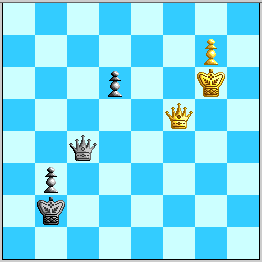
Diagram 6, White to play. No way to shake Black's cover of g8.
A large part of White's winning strategy in both the 54. Qf2 Qd3 win and the 54. Qf4 Qd3 win is to reach this position with Black's b-pawn back at b4, when Qf7! wins (and seems to be the only way to win!). But with Black's b-pawn already at b3, the plan is punchless. This position was well known to the World Team, since it was reached also in 52...Kc1 analysis. White's only play here seems to be 64. Qf3, but 64...Kc1! equalizes.
A32232) 59.Kg6 Qe8+! (simplest) 60.Kh7 (60.Kh6 Qg8! 61.Qd4+ Kc1 62.Qxd6 b2, is equal) 60...Qf7!
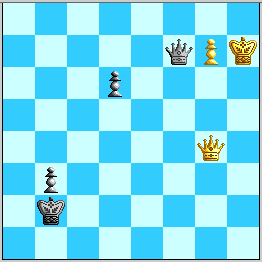
Diagram 7, White to play. The second-row defense---was it underestimated?
(Not 60...Qe7? 61.Qd4+ Kc2 62.Kh8, and White wins.) After the text Black is OK in comparison to the main line in 54. Qf4 Qd3, as the Black b-pawn is already at b3. Now 61.Qg5 Kc2 (not 61...Ka2? 62.Kh8, winning for White) 62.Kh8 b2, is equal.
Hence White cannot win with 55. g6. The contest now revolves around White's efforts to pick up a tempo with a timely check on the g-file, thus preventing Black's b-pawn from reaching b3. Note that 55. Qc1+?! Ka2 leaves White permanently out of touch with that file, and now 56. Qc2+ Ka3! 57. Qc3+ Ka2 58. g6 b4! is fine for Black, as 59. Qxb4 Qe5+ is the same perpetual check as above.
B. 55.Qf1+ Ka2 56. Qf2+ Ka3! (going back to the 1st rank loses as in line I. at the top of this file) 57. Qg3+ (instead, 57. Qe3+ Ka2 58. g6 b4 59. g7 b3 is just ineffective for White; checks on a7 don't help either), and now Black has a choice:

Diagram 8, Black to play. Two moves draw, one move loses (we do not count 57...Kb4? as a move).
The demonstration that 57...Ka2? loses but the b-pawn-blocking 57...Kb2 holds is below. However, the cleanest and most thematic draw pulls the idea of "Strategy K" from the World Team Endgame Strategy article:
57...Ka4!
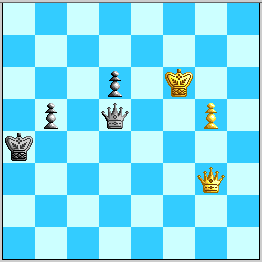
Diagram 9, White to move. Black plays "Strategy K".
Now 58. g6 b4 59. g7 Qd4+ 60. Kg6 Qe4+ 61. Kg5 Qd5+ 62. Kh4 is fine for Black so long as Black avoids 62...Qh1+? 63. Qh3!, when suddenly White's control over e6 makes this dangerous. Instead, 62...Qg8! is well-timed.
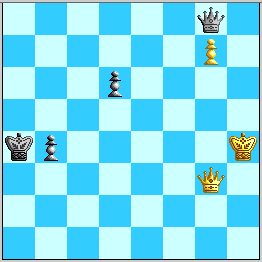
Diagram 10. With no checks, White cannot regroup in time.
If White could play 63. Kg3, then 63...b3 64. Qf4+ Ka3 65. Qf8 would win, but he can't, and 63. Qg5 b3 64. Qf4+ Ka3 65. Qf8 Qc4+ 66. Kg5 Qd5+! (covering a8) 67. Kf6 b2 is a draw. Likewise 63. Qg4 Ka3 64. Qf3+ b3 65. Qf8 Qc4+ is nothing for White.
If instead White tried 62. Kh6, then 62...Qh1+! draws. And 62. Kf4 achieves nothing with Black's King sheltered from checks. The only other try seems to be 58. Qg4+ b4 59. g6, but 59...Qe5+ leaves a situation where White cannot offer a Queen trade, so it's a draw. There seems to be nothing more to this line!
An examination of this last line compared to the note to Move 53 in the game (explaining why Black had to play 53...Ka1 not 53...Ka3) shows exactly where 54. Qf4? lost a tempo---it allows Black's Queen to get from d1 to d5!
Conclusion: After Kasparov's 54. Qf4?, 54...Qd5! draws.
Addendum on 54. Qf4
Qd5!---two pretty losses and a second draw.
After 54. Qf4 Qd5 55. Qf1+ Ka2 56. Qg2+ Ka3 57. Qg3+, it is instructive to see how 57...Ka2 loses: 58. g6 Qd4+ (here this limits White better; 58...b4 59. g7 Qd4+ gives White the extra winning option of 60. Kg6 Qe4+ 61. Kg5! Qd5+ 62. Kh4! as shown below) 59. Kf5 Qd5+ 60. Kf4 b4 61. g7 Qg8! Further checks would have only helped White, but now White has a nice little challenge.

Diagram 11, White to move and win. A pretty study.
The win is 62. Qf2+! and
I. 62...Kb1 63. Qg1+! and now:
A) 63...Kc2 64. Qg6+! Kc1 (64...Kb3/b2/c3 65. Qf6(+) is even better than having White's Queen on e7 or d4 here, and 64...Kd1/d2 65. Qxd6+ is EGTB+/- #23) 65. Kg3! and now:
A1) 65...b3 66. Qg5+ Kd1 (else check and Qf8) 67. Qg4+ Ke1 68. Qe4+ and Qf3/f4+ next is "staircase wit".
A2) 65...Qb3+ 66. Kh2! Qg8 67. Kg1! is the end.
B) 63...Kb2 64. Qd4+ Kc1/c2 (...Kb3 65. Qf6!, or ...Ka2/a3 65. Qa7+ transposing) 65. Kg3!! OK, with 64...Kc1 this needs a little more: 65. Kg3 Qb3+ 66. Kg2! (nicely avoiding the annoyance of 66. Kf2 Qf7+) Qc2+ (else 67. Kg1!) 67. Kf3! Qc6+ 68. Kf4! and done.
C) 63...Ka2 64.Qa7+
C1) 64...Kb3 65.Qe7 Ka2 see 64...Kb1 (65...Qc4+ 66.Kf5 Qd5+ 67.Kf6 Qf3+ 68.Ke6 Qe2+ 69.Kxd6 Qd3+ 70.Kc7 Qc4+ 71.Kb6 Qd4+ 72.Kc6 Qc4+ 73.Qc5 Qa6+ 74.Kd7 Qb7+ 75.Qc7 Qd5+ 76.Ke7 Qg5+ 77.Kf8 Qh6 78.Qe5+-);
C2) 64...Kb2 65.Qe7 Ka2 see 64...Kb1;
C3) 64...Kb1 65.Qe7 Ka2 *Key Position B* (65...Qc4+ 66.Qe4++-; 65...b3 66.Qf8 Qc4+ 67.Kg5 Qc1+ 68.Qf4 Qg1+ 69.Qg4 Qe3+ 70.Kf6 Qe5+ 71.Kf7 Qd5+ 72.Qe6 Qh5+ 73.Qg6++-) 66.Qf8 Qc4+ 67.Kg5! Qd5+ 68.Qf5 Qg8 69.Kf6 Qd8+ (69...b3 70.Qe6 Qd8+ 71.Kg6+-) 70.Kg6 Qe8+ (70...b3 71.Qf7+-) 71.Kh7 Qe7 72.Qf4+-
II. 62...Kb3! 63.Qd4! Ka4 64.Kg5 Kb5 65.Qd3+
(65.Kg6 b3 66.Qxd6 b2 67.Qe5+ Ka4 68.Qxb2 Qe8+!=; 65.Kf6 b3 66.Qxd6 b2 67.Qe5+ Ka4 68.Qxb2 Qd8+!=) 65...Ka5 66.Qf5+
A) 66...Ka6 67.Kf6
A1) 67...Qd8+ 68.Kg6 Qa8 (68...b3 69.Qe6+-; 68...Qe8+ 69.Kh7 Qe7 70.Qf4+-) 69.Qd3+ Ka5 70.Kf7+-;
A2) 67...b3 68.Qe6 Qd8+ 69.Kg6+-;
B) 66...Kb6 67.Kf6
B1) 67...b3 68.Qe6 Qd8+ (68...Qxe6+ 69.Kxe6 b2 70.g8Q b1Q 71.Qb8++-) 69.Qe7+-;
B2) 67...Qd8+ 68.Kg6 Qe8+ (68...b3 69.Qf8+-; 68...Qa8 69.Qf2+ Kb5 70.Qf7+-) 69.Kh7 Qe7 70.Qf4+-;
C) 66...Ka4 67.Qd7+! Ka3 (67...Ka5 68.Qa7+ Kb5 69.Kf6 b3 70.Qf7 Qd8+ 71.Ke6, winning for White) 68.Qa7+ Kb2 69.Kf6 Qd8+ 70.Kf7+-
But, at Move 57 Black can play
57...Kb2 58.g6 Qd4+ (58...b4 would transpose after 59.g7 Qd4+ 60.Kf5 Qd5+ 61.Kf4, but again allows White the apparently winning option 60. Kg6 Qe4+ 61. Kg5 Qd5+ 62. Kh4!) 59.Kf5 Qd5+ 60.Kf4 b4 61.g7 Qg8!
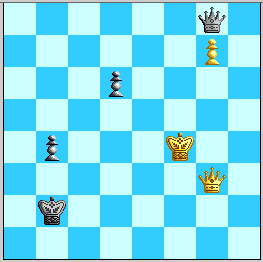
Diagram 12, White to play and cannot win. A cooked study.
If 62.Qf2+, Black can draw with his one extra option:
B3) 62...Kc3! 63. Qe1/e3+ (63.Qg3+ Kb2 repeats) Kc2! 64. Qe4+ Kc3. White has attained a maximum, and would win if his Queen had been checking c2 from g6 as above, but now the best White has is 65. Qc6+ Kb2!---and then not much more, e.g. 66. Qc7 b3 67. Kg3 Qd5! and White is just not doing it.
62.Ke3 (a better try than 63. Kf3 b3=) b3! (62...Qe6+? 63. Kf2 and 62...Qb3+ 63. Kf2 Qc2+ 64. Kf1! Qc4+ 65. Kg1 ! only help White) 63. Qf2+! Kc1! 64. Qf1+! Kc2! 65. Qg2+ sets a trap: 65...Kc1? 66. Kd3!! is an enchanting win: 66...Kb1 67. Kc3 Qc8+ 68. Kxb3 is EGTB+/- #39. However, 65...Kb1! holds. Now 66. Kd2!? b2 67. Qf1+ Ka2 68. Qa6+ Kb1 69. Qb7 Ka2?! 70. Kc3! is that rare situation where Knight underpromotion is the only way to save Black!: 70...b1=N+ 71. Kd4 Nd2! and seems to draw since 72. Qd5+ Nb3+! wins, and 72. Kd3 Qh7+ 73. Kxd2 Qh6/h2+ is EGTB=. But 69...Ka1 is safer, and 69...Qh7!, even better!
However, if Black is not careful with move order, Black gets in trouble:
57...Kb2 58. g6 b4? 59. g7 Qd4+ 60. Kg6!, and now:
A. 60...Qe4+ 61. Kg5! Now 61...Qe6/c4 62. Qg4! is a known theme, and 61...Qh7 62. Kf6! is clearly +/- as well. On 62...Qe7+, White shifts gears with 63. Kf5! Qd7/f7+ 64. Ke4! Now we get the following lines:
Thus Black is down to
B. 60...Qd5+,
but now 61. Kh4!! is on!

Diagram 13. The difference between f4 and h4 for White's King matters!
Now 61...Qc4+ 62. Qg4 and 61...Qd4+ Kh3 are immediate +/-, and 61...Qg8 fails to 62. Qf2+ Ka3/b3/c3 63. Qf8 Qc4+ 64. Kg3+/- (always 63...Qh7+ 64. Kg5!+/-), or 62...Ka1 63. Qf8 Qc4+ 64. Kg5 Qd5+ (64...Qc1+ 65. Qf4 Qg1+ 66. Qg4 Qe3+ 67. Kg6 Qd3+ 68. Kf7 Qd5+ 69. Kf8 Qa8+ 70. Ke7 Qa7+ [70...Qg8 71. Qg1+ Ka2/b2 72. Qf2+ K-any 73. Qf7+/-] 71. Kf6 Qf2+ 72. Kg6 Qc2+ 73. Qf5 Qc4 74. Qf6+ +/-) 65. Qf5 Qg8 66. Qa5+ +/-, or 62...Kb1 63. Qf8 Qc4+ 64. Kg5 Qc1+ 65. Qf4 Qg1+ 66. Qg4 is +/- with a crosscheck on f5 coming down the line, or 62...Kc1 63. Qf4+! Kc2/d1 64. Qf8 Qb3+ 73. Kg5/g3 +/-.
So Black dives in with 61...Qh1+, and we reach our most delicate case: 62. Kg4 Qd1/e4+ 63. Kh3 Qe6/f5/h5/h7+ 64. Kg2. Now we have a position where further checks only help White reach the positions after 62...Qe7+ at the beginning of this line, so Black must duck with 64...Qg8, hoping to catch White's King on g2 at a bad time.
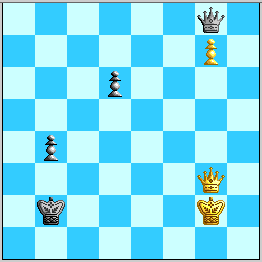
Diagram 14. Black will get a new Queen, but not a draw!
White has built a "Cannon" on the g-file. It fires by 65. Qf2+, and now:
65...Kc1 66. Qf4+ Kc2 (...Kd1 67. Qf8+/-) 67. Qf5+ Kc1/d2 68. Qg5+ Kd1 69. Qg4+ Kc1/c2 70. Kf2! b3 71. Qf4/f5+ K-any 72. Qf8+/-, or 70...Qf7+ 71. Kg1+/-. Or 67...Kb3 68. Qf6 and soon +/-.